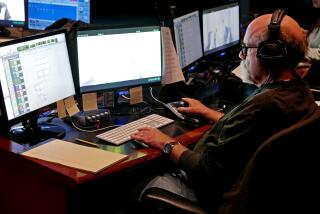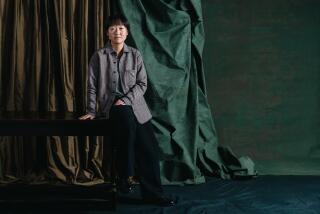Review: What does sound look like? Artist Christine Sun Kim’s funny, at times enthralling answers
- Share via
In her delectable video “Classified Digits,” Christine Sun Kim articulates, in American Sign Language, a dozen or so awkward scenarios: running into your ex, Skyping with spotty WiFi, looking askance at another’s shopping cart in the checkout line, attempting unsuccessfully to join a group discussion.
Each situation involves a sort of connection, either desperately sought-after or vigorously unwanted. The 5½-minute video plays like a straightforward instructional tape, with intertitles announcing the circumstances and Kim facing the camera before a neutral background, but slippage is built into the staging.
Her arms are pulled behind her back; those of her collaborator, Thomas Mader, who stands close behind her, wrap around her and speak on her behalf. Together, his hands and her facial expressions enact each mini scene. His tattooed bicep emerging from her petite trunk makes physical comedy out of the inherently imperfect art of communication.
The video is part of Kim’s subtly enthralling Ghebaly Gallery show, which also includes a wall mural, four-channel video installation and two compelling groups of charcoal drawings. One of the series, “The Sound Of,” is part musical notation, part concrete poetry. Each sheet is a visual and verbal evocation of a state of being. Kim uses a lexicon of just two symbols — F for forte, or loud, and P for piano, or soft. The score markings serve as raw material, preloaded with familiar dynamic function but also repurposed through Kim’s canny use of repetition and rhythm.
“The Sound of Anticipation,” with its row upon row of single and double Fs, invokes stuttering urgency. A similar pattern of Ps conjures stillness and sameness, “The Sound of Inactivity.” Both symbols congregate in clunky, irregular masses that slow each other down or cancel each other out in “The Sound of Laziness.”
In “Just Music,” Kim, based in Berlin, visually extrapolates from the descriptive captions appearing in film and television scenes without dialogue. She foregoes use of a musical staff and relies instead only on an all-purpose musical note, legato marks and the space of the page to suggest “Suspenseful Background Music,” “Very Fast Rap Song” and more. The notes of “Classical Flute Music” frolic neatly from left to right, chipper and controlled. Those constituting “Epic Ominous Music” thud and sink, as if doomed. In both sets of drawings, stray smudges and smears of charcoal read as ambient sounds, the found music — à la John Cage — of the every day.
Kim conceives afresh of sound’s physicality and its visual properties, of verbal and musical expression as embodied in motion and gesture. Through wry humor born equally of futility and possibility, she helps broaden understanding of the myriad forms through which voice is channeled.
Ghebaly Gallery, 2245 E. Washington Blvd., L.A. Through Saturday. (323) 282-5187, www.ghebaly.com
See all of our latest arts news and reviews at latimes.com/arts.
More to Read
The biggest entertainment stories
Get our big stories about Hollywood, film, television, music, arts, culture and more right in your inbox as soon as they publish.
You may occasionally receive promotional content from the Los Angeles Times.










